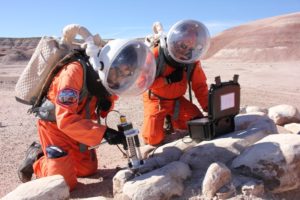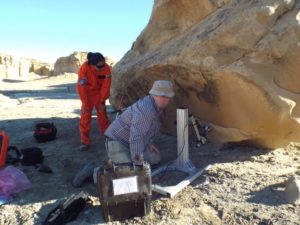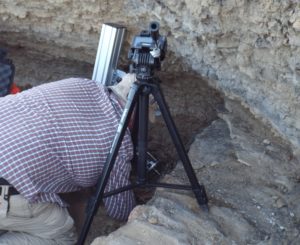Science Report – November 22nd
Constraints of Science Operations on Mars: Lessons Extracted while Performing Simulation
By Crew Biologist Anushree Srivastava
We are performing Mars simulation in the Utah Desert and doing rigorous science on field during intense extra-vehicular activities (EVAs). However, sometimes your approaches on field are constrained in heavy spacesuits and in absence of highly specialised equipment. That is what I learned while performing science operations during EVAs. I encountered this limitation while sampling for three prominent science projects I am working on as Crew Biologist – lichen biodiversity, exploration of ‘exotic’ hypolith communities and their ecology, and ancient gypsum for halophile research.
A proper sample collection regime in sterilised conditions is the first and the most significant step to consider before those samples are processed in the laboratory. We, as part of Mars 160 mission, are simulating a long-term Mars simulation mission whose one of the prime objectives is to test the efficiency of human explorers while performing science operation on Mars. Therefore, whenever we go out on the red and stunning Mars-like bumpy land of the Utah Desert, we are fully geared up in our orange flight suits, a heavy tank on our backs which approximately weighs 12 kg, a helmet attached with the tank to provide us sufficient air to breath while being locked inside the helmet that weighs another 1 kg, and boots, and gloves that add extra 1.5 kg. Additionally, if we are sampling, we are required to carry our tool bags as well as a camera which means another 1-2 kg on your body. So, overall, you are incurred with 15-17 kg while you are doing science on field in full-simulation suit. Although, we have done exemplary jobs by reaching high and steep cliffs to collect samples while carrying this weight, I realised that we are certainly constrained by this weight on our bodies. While performing this Mars simulation on field I learned that it is practically not possible to access some of those high and interior locations in space suits. Furthermore, thick and heavy gloves sometimes limit your ability to handle tools and samples efficiently.
Sampling with highly specialised tools in sterilised conditions on Mars is another concern which dawned on to me while observing the UK Space Agency folks testing their robotic sampling instruments during the field trials here in the Utah Desert, which is called SPLIT: The Small Planetary Linear Impulse Tool. SPLIT or “specialised geological hammer” is able to chip off the rock aseptically by continuous percussion on the surface of rock even in the temperature as cold as minus 50 degrees Celsius. I found multiple unique pattern of lichen colonization on a big and highly cemented boulder of sand stone at same location, but the position of the lichen colonization on the boulder made it difficult for me break the rock and obtain the desired sample. While discussing the lichen sampling strategy on field, John Holt, who was the chief of field trials of SPLIT instrument, told us that he can test SPLIT to extract a piece of rock from the location we indicate with minimal risk of contamination.
So not only in terms of SPLIT, but on the whole, I found it all amazing and a novel way of sampling in the field where the samples seem precious but geological features are intricately complicated. Another example when I felt this lack of specialised sampling tool is when our Crew Geologist Dr Jon Clarke was indicating me a very thin and shiny layer of gypsum deeply embedded in a high cliff of Cretaceous period, during one of our EVAs. I wanted to extract the pieces of gypsum from the thin layer but I could not because the equipment we had was not sufficient to obtain a nice chunk of gypsum for further processing in the laboratory. One more, and a very recent example of this helplessness, is during my last EVA when I was also testing a different suit with integrated backpack and helmet. During the EVA we had to climb ~ 5 meters high cliff for lichen sampling and I also wanted to explore the rare hypoliths in the sandstone in the remaining time. I found this integrated space suit uncomfortable and inflexible from sampling point of view because I was constantly trying to climb up and down to explore more sandstone boulders, but at a point I got stuck, almost slipped and could not proceed because safety first! Then I felt this urge to have specialised instruments which should be complementary to our space suits to obtain the desired samples. And that’s when I felt that I must write about it.

Dr John Clarke and MURFI Mission Commander Mike Curtis-Rouse testing SPLIT.

John Holt applying SPLIT on a big sandstone boulder and me observing.

John Holt applying SPLIT on a big sandstone boulder and me observing.

SPLIT: The Small Planetary Linear Impulse Tool
I also talked with Dr Jon Clarke about his views on these constraints and he said “They are of two types. Limitations of available equipment and limitations imposed by the suit. The first, while sometimes frustrating in the short term, is something that can be remedied on future crews and expeditions. The second class is the more significant, because it points to the need for specialised equipment and procedures, perhaps as yet undeveloped, to overcome them. The specialised equipment might come with its own limitations, such as power and weight, which place additional constraints on operations. For example, a rock saw might enable lichens in the middle of large boulders or outcrops to be sampled, but would be heavy and require fuel and water. It could only be used near a support vehicle.”
Despite all of these complications, we are accomplishing our science goals on field, and most importantly, in full simulation suit. Personally, I feel human exploration of Mars is far more challenging as well as efficient in terms of science operations, as we possess the will of explorers and the desire to surrender ourselves to achieve higher science goals. If equipped with specialised tools and techniques, I think human astrobiological exploration of Mars can be highly focused and productive.
Above all, I learned that preparation for the excursion to Mars for astrobiological exploration is not just limited to having a solid research objective in mind or a protocol on the paper or applying those protocols in an analog environment, but it also demands immense human mental and physical mettle to reach almost inaccessible nooks and corners and sometimes putting your life into risk for the sake of science and for the sake of having a flavour of what it actually takes to explore Mars. That’s what this simulation told me. And in that sense, I think I have discovered myself as an explorer.



